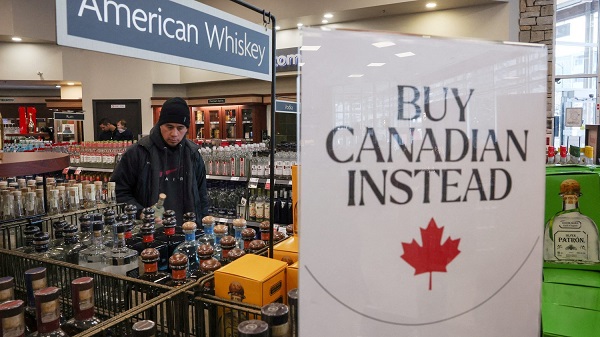National
Furey a major contrast with Trudeau on affordability

From the Canadian Taxpayers Federation
Author: Jay Goldberg
If Canadians want to find an example of a Liberal politician who cares about affordability, they should look to St. John’s, not Ottawa.
Time and time again, Newfoundland and Labrador Premier Andrew Furey has stood on the side of taxpayers.
The latest example is his government’s decision to extend its 8.05 cent per litre gas tax cut for another year.
The gas tax cut has been in place for 21 months and has saved the average two-car Newfoundland and Labrador family more than $800. Another 12 months of lower gas prices will see family savings soar to more than $1,000.
Furey first announced the temporary tax cut in June 2022 and has now extended it twice.
The Furey government has also spoken out strongly about the detrimental impact of the carbon tax on Newfoundlanders and Labradorians.
In criticizing the Trudeau government’s carbon tax late last year, Furey noted “there is no subway” for his constituents to take as an alternative to the ever-increasing costs of driving a car to get to work or to bring kids to school.
That comment was a jibe at the infamous remarks federal Finance Minister Chrystia Freeland made when encouraging Canadians who can’t afford to pay the carbon tax to bike or take transit.
Furey noted if rural Canadians don’t have other transit options – and many don’t – then “the fundamental premise on which the [carbon tax] is based is flawed.”
Furey was also a leader in calling on Trudeau to take the carbon tax off all home heating, noting repeatedly that heating one’s home in Canada in the winter is not optional.
Under pressure, Trudeau finally did so through a temporary suspension of the carbon tax on home heating oil, which is a popular method of home heating in Atlantic Canada, but not in other regions of the country.
To Furey’s credit, he continued to call on the federal government to offer relief to Canadians who don’t use furnace oil for home heating.
Juxtapose that against the policies of Prime Minister Justin Trudeau.
Without campaigning on it, Trudeau sprung a carbon tax on Canadians in 2019. He’s increased it every year since. And he plans to keep jacking it up every year until 2030.
Trudeau has tried to sell his policies by claiming most Canadians are getting more money back from carbon tax rebates than they pay in carbon taxes. Many of Trudeau’s allies have suggested that somehow the carbon tax actually is an affordability measure.
But the Parliamentary Budget Officer has laid out the truth: the average Canadian family is losing money from the carbon tax, big time.
The average Newfoundland and Labrador family lost $347 from the carbon tax last year, even after the rebates. That’s set to climb to $1,316 a year by 2030.
For years, Trudeau told us families would be better off with the carbon tax. But after pressure from Furey and other Atlantic Canadian politicians, he temporarily removed the carbon tax on home heating oil for the next three years.
If that’s not a mea culpa that the carbon tax makes life less affordable, then Santa Claus and the Easter Bunny must be real.
The broader contrast between Furey and Trudeau is their approach to cost of living. Furey looks at what’s taking cash out of families’ wallets – gas and carbon taxes – and tries to lessen that burden by fighting for lower taxes. Trudeau’s solution to make life more affordable appears to be more taxes, more spending and more debt.
The bottom line is that Trudeau, who is sinking in the polls and faces frustrated taxpayers from coast to coast, should learn a thing or two from Furey. Canadians want life to be more affordable, and that means lowering the tax burden, not increasing it.
Business
Canada’s economic pain could be a blessing in disguise

This article supplied by Troy Media.
 By Roslyn Kunin
By Roslyn Kunin
Tariffs, inflation, and falling incomes sound bad, but what if they’re forcing us to finally fix what’s broken?
Canada is facing serious economic headwinds—from falling incomes to rising inflation and U.S. trade hostility—but within this turmoil lies an opportunity. If we respond wisely, this crisis could become a turning point, forcing long-overdue reforms and helping us build a stronger, more independent economy.
Rather than reacting out of frustration, we can use these challenges to reassess what’s holding us back and move forward with practical solutions. From
trade policy to labour shortages and energy development, there are encouraging shifts already underway if we stay focused.
A key principle when under pressure is not to make things worse for ourselves. U.S. tariffs on Canadian steel and aluminum, and the chaotic renegotiation of NAFTA/CUSMA, certainly hurt our trade-dependent economy. But retaliatory tariffs don’t work in our favour. Canadian imports make
up a tiny fraction of the U.S. economy, so countermeasures barely register there, while Canadian consumers end up paying more. The federal government’s own countertariffs on items like orange juice and whisky raised costs here without changing American policy.
Fortunately, more Canadians are starting to realize this. Some provinces have reversed bans on U.S. goods. Saskatchewan, for example, recently lifted
restrictions on American alcohol. These decisions reflect a growing recognition that retaliating out of pride often means punishing ourselves.
More constructively, Canada is finally doing what should have happened long ago: diversifying trade. We’ve put too many economic eggs in one
basket, relying on an unpredictable U.S. market. Now, governments and businesses are looking for buyers elsewhere, an essential step toward greater stability.
At the same time, we’re starting to confront domestic barriers that have held us back. For years, it’s been easier for Canadian businesses to trade with the U.S. than to ship goods across provincial borders. These outdated restrictions—whether on wine, trucks or energy—have fractured our internal market. Now, federal and provincial governments are finally taking steps to create a unified national economy.
Labour shortages are another constraint limiting growth. Many Canadian businesses can’t find the skilled workers they need. But here, too, global shifts
are opening doors. The U.S.’s harsh immigration and research policies are pushing talent elsewhere, and Canada is emerging as the preferred alternative.
Scientists, engineers and graduate students, especially in tech and clean energy, are increasingly choosing Canada over the U.S. due to visa uncertainty and political instability. Our universities are already benefiting. If we continue to welcome international students and skilled professionals, we’ll gain a long-term advantage.
Just as global talent is rethinking where to invest their future, Canada has a chance to reassert leadership in one of its foundational industries: energy.
The federal government is now adopting a more balanced climate policy, shifting away from blanket opposition to carbon-based energy and focusing instead on practical innovation. Technologies such as carbon capture and storage are reducing emissions and helping clean up so-called dirty oil. These cleaner energy products are in demand globally.
To seize that opportunity, we need infrastructure: pipelines, refining capacity and delivery systems to get Canadian energy to world markets and across our own country. Projects like the Trans Mountain pipeline expansion, along with east-west grid connections and expanded refining, are critical to reducing dependence on U.S. imports and unlocking Canada’s full potential.
Perhaps the most crucial silver lining of all is a renewed awareness of the value of this country. As we approach July 1, more Canadians are recognizing how fortunate we are. Watching the fragility of democracy in the U.S., and confronting the uncomfortable idea of being reduced to a 51st state, has reminded us that Canada matters. Not just to us, but to the world.
Dr. Roslyn Kunin is a respected Canadian economist known for her extensive work in economic forecasting, public policy, and labour market analysis. She has held various prominent roles, including serving as the regional director for the federal government’s Department of Employment and Immigration in British Columbia and Yukon and as an adjunct professor at the University of British Columbia. Dr. Kunin is also recognized for her contributions to economic development, particularly in Western Canada.
Troy Media empowers Canadian community news outlets by providing independent, insightful analysis and commentary. Our mission is to support local media in helping Canadians stay informed and engaged by delivering reliable content that strengthens community connections and deepens understanding across the country.
Education
Students can’t use AI to cheat on standardized tests

From the Fraser Institute
As the schoolyear winds down, many students across Canada will hand in their final assignments and write their final exams. Cutting corners and outright cheating in school is easier than ever. If you need to write an essay, just plug in the assignment instructions and let artificial intelligence (AI) write it for you.
A recent New York Magazine article provided numerous examples of college students using AI to write formal essays, generate programming code, and even draft personalized notes. Whether you need help creating an outline, finding relevant sources or writing an introduction, AI can do all these things and more.
Many K-12 students also use AI for their assignments. Anyone who is worried about being caught just needs to tell ChatGPT (or whichever AI program they use) to make it look like the essay was written by a high school student.
Catching cheaters is nearly impossible—and it’s getting harder as AI gets increasingly sophisticated. Even so-called AI detectors like Turnitin, which scan essays for patterns that indicate the use of AI, are far from perfect. In other words, there’s no easy or low-cost way to prevent students from using AI on their homework assignments.
Obviously, this is a significant problem. If students use AI to do most of their homework, they aren’t going to learn important academic skills. This does not bode well for their future or the general productivity of our labour force.
Fortunately, there’s one academic measurement tool available that AI cannot interfere with—in-person standardized tests, which are administered to all students in a particular grade at the same time and are assessed by outside evaluators using consistent criteria. They can be grade-level tests or exams that are required for graduation.
For example, Grade 12 students in Alberta must write diploma exams in core subjects such as English language arts, mathematics, social studies and science. These exams are created by the provincial Ministry of Education and are marked centrally by a group of teachers. They count for 30 per cent of a student’s final grade, with the remaining 70 per cent coming from the school-awarded mark.
Because all students must write the same exam and are evaluated according to the same standard, it’s possible to objectively determine whether students have met the appropriate academic outcomes. Importantly, students cannot use AI when writing these exams since all diploma exams are strictly supervised.
Thus, even if some students had, for example, used AI to write their English essays at home, their diploma exam marks will reveal the true level of their writing ability. If there are significant discrepancies between the diploma exam mark and the school-awarded mark, this can indicate where changes need to be made.
Unfortunately, many provinces do not have diploma exams, and this leaves their schools more susceptible to cheating with AI. For example, while British Columbia requires all Grade 12 students to write (but not pass) a literacy assessment, this assessment does not count toward a student’s final grade. Even worse, the assessment is “not based on a particular subject matter or course.” Thus, the B.C. literacy assessment has little value in combating the problem of AI cheating. This puts the burden of catching cheaters entirely on teachers and principals.
To make matters worse, standardized testing is on the decline across the country. Over the last decade in most provinces, standardized tests have been administered at fewer grade levels, given less value by provincial governments, and turned into non-content specific assessments. This is exactly the wrong direction.
If provincial education ministries are serious about maintaining academic standards, they must ensure that students write standardized tests at multiple grade levels and in a variety of subjects. Students need to know that their performance on these tests will impact their final marks and that they only hurt themselves academically if they get AI to do their work for them.
When it comes to AI, we cannot put our heads in the sand. Since AI isn’t going away, it’s important that we assess students with measurement tools where students cannot use AI to cheat.
Instead of moving away from standardized testing, every province should embrace and enhance this important measurement tool. It’s the best way to ensure all students meet basic academic standards.

Michael Zwaagstra
Senior Fellow, Fraser Institute
-

 Health2 days ago
Health2 days agoLast day and last chance to win this dream home! Support the 2025 Red Deer Hospital Lottery before midnight!
-

 Aristotle Foundation2 days ago
Aristotle Foundation2 days agoThe Canadian Medical Association’s inexplicable stance on pediatric gender medicine
-

 Alberta2 days ago
Alberta2 days agoAlberta announces citizens will have to pay for their COVID shots
-

 Uncategorized2 days ago
Uncategorized2 days agoKananaskis G7 meeting the right setting for U.S. and Canada to reassert energy ties
-

 Business2 days ago
Business2 days agoCarney’s Honeymoon Phase Enters a ‘Make-or-Break’ Week
-

 conflict1 day ago
conflict1 day agoTrump leaves G7 early after urging evacuation of Tehran
-

 Crime1 day ago
Crime1 day agoUK finally admits clear evidence linking Pakistanis and child grooming gangs
-

 International1 day ago
International1 day agoTrump not seeking ceasefire with Israel, Iran as he rushes back to White House





